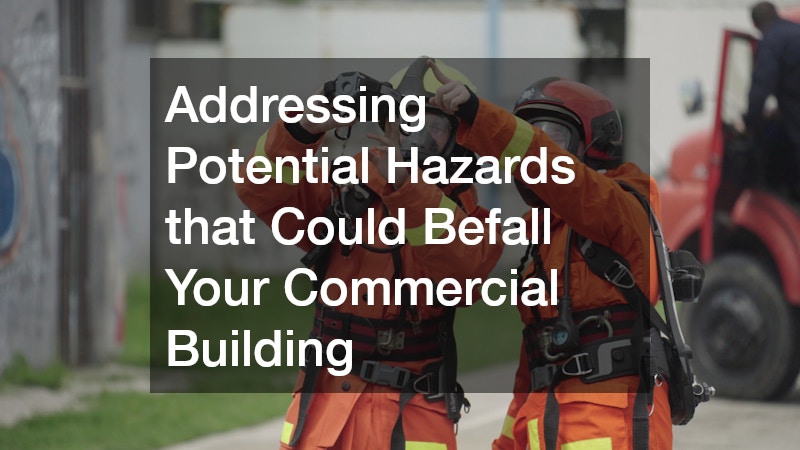
Commercial buildings are complex environments that house employees, clients, and valuable assets such as equipment, inventory, and property. Ensuring these assets remain safe requires a proactive approach to identifying and mitigating potential hazards. From structural vulnerabilities to environmental concerns, threats can emerge from many sources, often unexpectedly. Addressing these risks not only protects occupants but also ensures regulatory compliance and preserves the building’s long-term functionality. Understanding the common hazards and implementing preventive measures is essential for any property owner or manager aiming to maintain a secure, operational, and sustainable commercial space.
What Are Common Structural Hazards in Commercial Buildings?
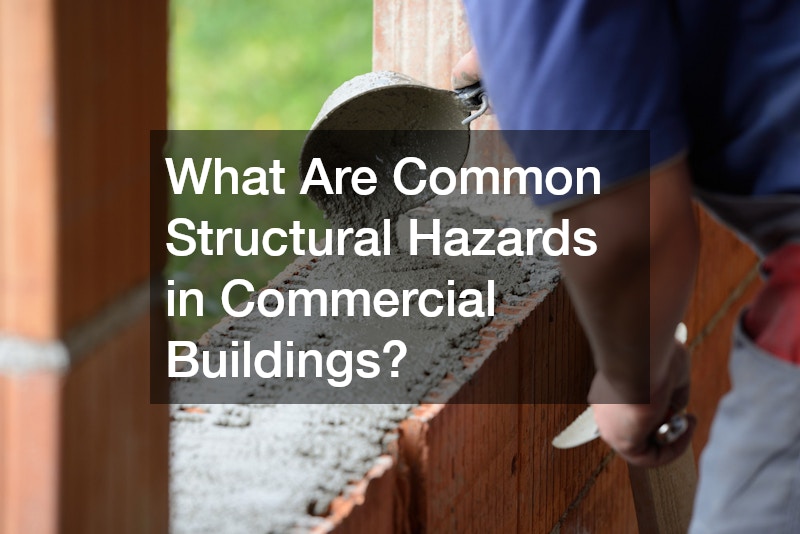
Identifying Weak Points in Construction
Structural hazards often arise from weaknesses in the original construction. These can include inadequate foundations, compromised load-bearing walls, or inferior materials. Professional inspections by structural engineers can identify these weak points early. Buildings with older construction may require retrofitting to reinforce vulnerable areas. For commercial properties, ongoing assessments are crucial, as structural problems can compromise both safety and business continuity.
The Impact of Weather on Structural Integrity
Weather conditions can exacerbate structural weaknesses over time. Heavy rainfall, snow accumulation, windstorms, and temperature fluctuations can stress building materials, leading to cracks or water intrusion. Regular inspections of commercial roofing are particularly important to detect leaks or deterioration caused by extreme weather. By addressing these issues proactively, property owners can avoid costly repairs and operational interruptions.
Regular Inspections and Maintenance
Routine inspections help detect structural issues before they escalate. Maintenance schedules should cover foundations, roofing, walls, and critical supports. Even minor issues, such as small roof leaks or cracks in concrete, can indicate larger structural concerns. Partnering with commercial property water remediation companies ensures that any water intrusion or damage is handled quickly and effectively, preventing further degradation.
Retrofitting and Reinforcement Strategies
Older buildings often require retrofitting to comply with modern safety codes. Reinforcement techniques may include steel supports, concrete reinforcement, or seismic bracing. Proper retrofitting not only enhances safety but also extends the building’s lifespan. In commercial settings, these improvements can also improve insurance outcomes, making roof insurance claims simpler if future incidents occur.
Case Studies of Structural Failure
Reviewing past structural failures provides insight into potential hazards. For example, roof collapses due to heavy snow or wall failures during storms highlight the consequences of neglecting inspections. Commercial buildings that have invested in regular maintenance, retrofitting, and professional roofing services tend to avoid these costly disasters.
How Can Fire Hazards Be Mitigated in Commercial Buildings?
Installation of Fire Suppression Systems
Fire suppression systems are essential for commercial buildings. Sprinklers, alarms, and automatic extinguishers help control the spread of fire and protect occupants. Integrating these systems with proper building design and fire-resistant materials strengthens overall safety. Regular maintenance of fire protection systems is crucial, especially in high-risk areas such as kitchens or storage rooms.
Developing and Practicing Emergency Evacuation Plans
Even with advanced suppression systems, having a well-planned and practiced emergency evacuation plan is critical. These plans should consider employees, clients, and visitors with limited mobility. Periodic drills ensure occupants understand escape routes, reducing panic during emergencies and preventing injuries.
Use of Fire-Resistant Materials in Construction
Incorporating fire-resistant materials in walls, ceilings, and flooring can slow the spread of a blaze. Modern commercial roofing systems often include fire-resistant materials that improve safety while minimizing damage. Combining these materials with protective coatings enhances both structural integrity and occupant protection.
Regular Fire Drills and Employee Training
Fire drills and ongoing employee training reinforce emergency protocols. Employees should know how to use fire extinguishers, recognize alarms, and safely evacuate hazardous areas. Frequent drills build confidence and reduce confusion during real emergencies.
Regulatory Compliance and Fire Safety Audits
Compliance with fire safety codes is mandatory. Commercial properties must adhere to local and national regulations for alarms, exits, and suppression systems. Conducting regular fire safety audits ensures compliance, minimizes liability, and reinforces a culture of safety.
What Role Does Electrical Safety Play in Preventing Hazards?
Common Electrical Hazards and Their Causes
Electrical hazards are a leading source of incidents in commercial buildings. Overloaded circuits, outdated panels, frayed wiring, and poor grounding are common risks. These hazards can lead to fires, shocks, or equipment damage. Proactive measures are crucial to prevent these dangers from compromising safety and operations.
Best Practices for Safe Electrical Installations
Safe electrical systems require adherence to codes and certified components. Circuit breakers, proper grounding, and correct load calculations reduce the risk of failures. Licensed electricians ensure installations meet safety standards, especially in older buildings with outdated wiring or heavy energy demands.
Importance of Regular Electrical Inspections
Routine inspections of electrical systems detect wear or potential hazards early. Inspectors examine wiring, panels, and connections to prevent overheating or short circuits. Commercial property managers benefit from periodic evaluations, reducing downtime and protecting assets.
Upgrading Old Electrical Systems
Many commercial buildings still operate with outdated electrical infrastructure. Upgrades such as new wiring, panels, and protective devices enhance safety, efficiency, and insurance compliance. Older systems may be incapable of supporting modern equipment, making timely upgrades essential.
Training Staff on Electrical Safety Procedures
Employee awareness is critical for electrical safety. Training staff to handle equipment safely, recognize hazards, and follow emergency shutdown procedures minimizes risk. Safety-conscious teams help maintain a hazard-free work environment.
How to Prevent Water Damage in Commercial Buildings
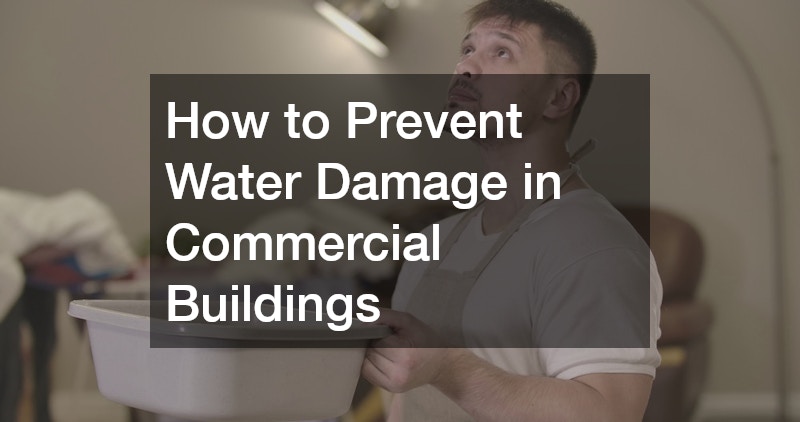
Identifying Potential Sources of Leaks and Floods
Water damage can stem from roof leaks, plumbing issues, or external flooding. Identifying these risks early is crucial. Regular assessments of commercial roofing, plumbing systems, and drainage infrastructure help prevent serious water intrusion.
Installing Effective Drainage Systems
Proper drainage protects building foundations and interiors. Gutters, downspouts, and stormwater systems direct water away from structures. Interior drainage systems and sump pumps are essential in flood-prone areas, especially for properties that rely on parking lot resurfacing to manage runoff effectively.
Routine Plumbing Maintenance
Plumbing services ensure water systems operate correctly and prevent leaks or bursts. Regular inspection of pipes, valves, and fixtures allows for early detection of corrosion or damage. Timely maintenance reduces water damage and operational disruptions, supporting overall building health.
Impact of Water Damage on Building Operation
Water damage affects structural integrity, electrical systems, and HVAC performance. Delays in addressing leaks can result in costly repairs, disrupted operations, and health hazards such as mold. Engaging commercial property water remediation companies quickly minimizes long-term damage and restores safe, functional spaces.
Insurance Considerations for Water Damage
Roof insurance claims are often necessary after water-related incidents. Maintaining records of inspections, repairs, and preventive measures can streamline claims and demonstrate diligence in protecting the property.
What Are the Potential Risks of HVAC Systems?
Common HVAC Issues and Their Implications
HVAC systems are critical for occupant comfort and air quality. Poorly maintained systems can fail, leading to extreme temperatures, increased energy costs, or reduced air quality. Air duct repair and sealing is often necessary to ensure proper airflow and efficiency.
Importance of Regular HVAC Maintenance
Routine maintenance prevents breakdowns and prolongs the life of equipment. Scheduled inspections, filter changes, and system calibration reduce energy waste and minimize the risk of emergencies. Well-maintained HVAC systems also protect sensitive equipment from temperature fluctuations.
Air Quality Concerns in Commercial Buildings
Poor air quality can impact health and productivity. Dust, mold, and other contaminants in ductwork reduce indoor air quality. Air duct repair and sealing not only improve efficiency but also prevent the circulation of pollutants throughout the building.
Energy Efficiency and System Upgrades
Upgrading HVAC systems can reduce energy costs and environmental impact. Efficient systems, combined with solar contractors who provide renewable energy solutions, allow buildings to lower operational expenses while maintaining comfort and sustainability.
Health and Comfort Considerations
Occupants’ well-being depends on consistent temperature control and clean air. Properly maintained HVAC systems reduce absenteeism, improve productivity, and contribute to a positive workplace environment.
How Does Pest Control Contribute to Hazard Prevention?
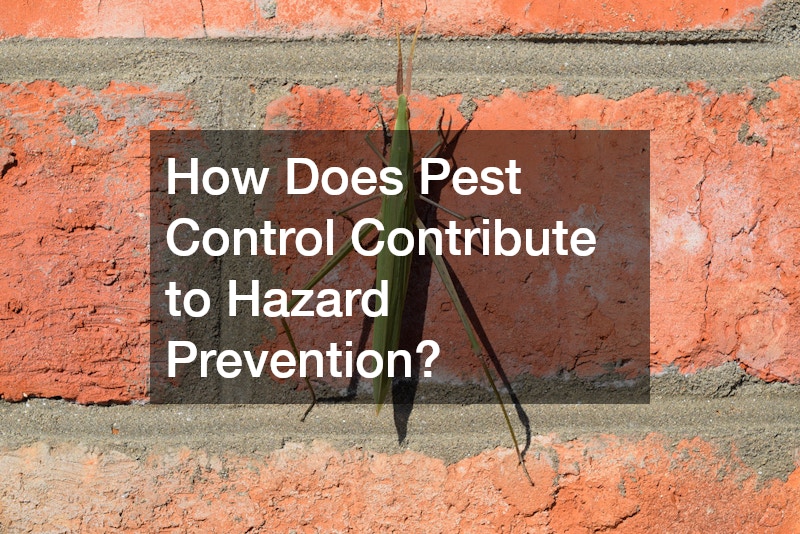
Identifying Common Pests in Commercial Environments
Commercial properties are prone to infestations of rodents, insects, and other pests. Identifying early signs of infestations is key to preventing structural and health hazards.
Health Risks Associated with Pest Infestations
Pests can carry diseases, contaminate food sources, and trigger allergies. Uncontrolled infestations pose serious risks to employees and customers, making prevention a critical aspect of building management.
Integrated Pest Management Strategies
Effective pest control integrates inspection, sanitation, and targeted interventions. Commercial property managers often partner with professional pest control services to ensure a safe environment and protect their reputation.
Monitoring and Prevention Techniques
Regular monitoring and preventive measures, such as sealing entry points and proper waste management, reduce pest activity. Ensuring that landscaping and surrounding areas are maintained can also minimize infestations.
Legal and Reputational Consequences of Infestations
Pest-related incidents can lead to fines, health code violations, and damage to a company’s reputation. Maintaining proactive pest control policies helps avoid these consequences.
In What Ways Can Environmental Hazards Impact Commercial Buildings?
Understanding Environmental Risk Factors
Environmental hazards such as radon exposure, air pollution, or soil contamination can affect building safety and occupant health. Engaging a radon testing service helps identify and mitigate these risks effectively.
Implementing Green Building Practices
Incorporating sustainable practices such as energy-efficient lighting, solar installations, and waste reduction strategies reduces environmental impact. Solar contractors can provide renewable energy solutions, enhancing both environmental and financial sustainability.
Compliance with Environmental Regulations
Commercial properties must comply with local environmental laws regarding emissions, waste disposal, and energy usage. Regular audits ensure that buildings meet all regulatory requirements and avoid penalties.
Strategies for Waste Management and Recycling
Effective waste management reduces hazards and supports sustainability. Recycling programs, proper disposal of hazardous materials, and coordination with service providers ensure that commercial buildings operate responsibly.
Adapting to Climate Change Impacts
Commercial buildings must anticipate extreme weather events and temperature fluctuations. Measures such as reinforced commercial roofing, upgraded drainage systems, and resilient HVAC infrastructure protect property and occupants.
What Are the Implications of Insufficient Security Measures?
Risks Associated with Inadequate Security
Insufficient security can lead to theft, vandalism, or workplace violence. Commercial buildings require comprehensive strategies to safeguard occupants, property, and sensitive information.
Designing an Effective Security Plan
Security planning involves evaluating potential vulnerabilities, installing surveillance equipment, and implementing access control. CCTV for parking lot and entryway areas provides real-time monitoring, while security personnel ensure rapid response to threats.
Technologies for Enhancing Building Security
Modern security systems integrate alarms, electronic locks, and surveillance technologies. Access controls for employees and visitors help maintain safe operations while protecting assets.
Employee and Visitor Access Control Systems
Limiting access to restricted areas reduces the risk of theft and accidents. Badge systems, biometric access, and digital logs enhance accountability and maintain a secure environment.
Responding to Security Breaches and Emergencies
A clear response plan is essential for emergencies. Coordination with local authorities, security teams, and building management ensures quick and effective mitigation of threats.
How Does Proper Signage and Wayfinding Promote Safety?
Importance of Clear and Visible Signage
Signage guides occupants safely throughout commercial buildings. Clear labels for exits, hazards, and restricted areas reduce accidents and improve compliance with safety standards.
Regulatory Requirements for Signage
Local and national codes dictate the placement and visibility of safety signage. Ensuring compliance protects both occupants and the building owner from liability.
Designing Effective Wayfinding Systems
Wayfinding systems help visitors navigate complex commercial spaces. Incorporating maps, directional signs, and digital indicators improves safety and enhances the user experience.
Signage for Emergency Routes and Exits
Emergency signage must be clearly visible, well-lit, and strategically located. These signs are critical during evacuations and fire incidents, guiding occupants to safe areas.
Maintenance of Signage Systems
Regular checks and updates ensure that signage remains legible and accurate. Faded or obstructed signs can compromise safety and reduce compliance with regulatory standards.
What Role Does Staff Training and Awareness Play in Hazard Prevention?
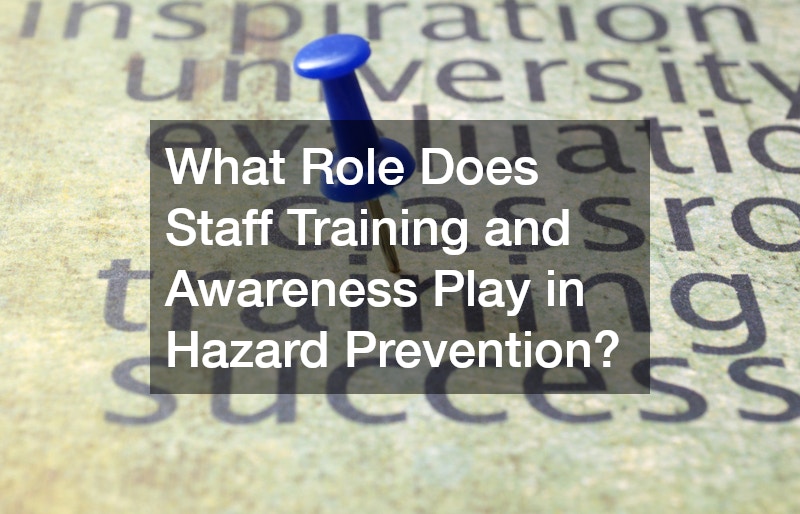
Developing Comprehensive Training Programs
Employees should be trained to recognize hazards, follow safety protocols, and respond appropriately to emergencies. Comprehensive programs cover structural, electrical, fire, and environmental hazards.
Importance of Safety Drills and Simulations
Practical drills help staff practice procedures in realistic scenarios. Simulations of fire, flood, or security incidents reinforce knowledge and preparedness.
Encouraging a Culture of Safety Among Employees
Creating a culture that prioritizes safety encourages vigilance and accountability. Employees who are empowered to report hazards contribute to a proactive safety environment.
Regular Updates and Refreshers on Safety Protocols
Safety protocols must evolve with building modifications, regulatory changes, and emerging risks. Ongoing training ensures that staff remains informed and prepared.
Evaluating the Effectiveness of Training Programs
Assessment and feedback identify areas for improvement in training programs. Measuring effectiveness ensures that education translates into safer practices and reduced hazard incidence.
Final Thoughts
Proactively addressing potential hazards in commercial buildings safeguards occupants, preserves property, and maintains operational efficiency. From structural integrity and fire safety to HVAC systems, plumbing services, and environmental considerations, regular inspections, maintenance, and staff training are essential. Integrating professional services such as commercial roofing, commercial property water remediation companies, radon testing service, solar contractors, and air duct repair and sealing ensures comprehensive protection. Attention to security, parking lot resurfacing, exterior painting service, and roof insurance claims further supports hazard prevention. By adopting a holistic approach, commercial property owners can create a safe, resilient, and productive environment for all.
